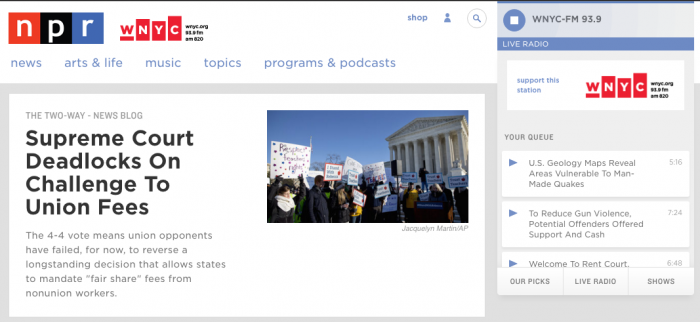With NPR’s new audio player, Flash is out and HTML5 is in. This morning, NPR unveiled a new, more seamless version of its web audio player, replacing the one it launched way back in 2007. (For perspective: That’s the year the first-generation iPhone launched.) The new player is built to make it easier to listen to not only NPR’s programs, stories, and podcasts, but content from its member stations as well.
“The overarching goal here was to replace the player with one that benefited our listeners, member stations and sponsors all at once. We spent a lot of time thinking about each one of those groups,” said Patrick Cooper, NPR’s director of web and engagement. “From the listener perspective, we want more people listening and want them to listen longer.”

The new player.

The old player.
Some notable changes:
The popup is dead. The previous version of the player lived in a popup window separate from its main page — not exactly the most seamless experience. NPR has replaced that with a persistent player that keeps playing even as users click through the site and queue up more stories. This makes it easier for NPR to track and measure how visitors are using the site. The new player also lets users resume listening if they accidentally close their browser windows.
Oh man, I accidentally closed my NPR window and when I came back, it still had my queue and it let me resume. My love is real.
— Linda Holmes (@nprmonkeysee) March 29, 2016
No more Flash. Flash has been in decline since Apple refused to support it on iPhones, and it’s losing support among the big browsers, websites, and even Adobe itself. Replacing it with HTML5 makes the site far faster, NPR says.
Deeper connections between listeners and member stations. When listeners click over to NPR’s website, the new player will automatically localize their experience by loading live streams from their local radio stations. NPR wants to make it easier for listeners to engage with their local stations, not just its national newscasts.New ad units. No new product launch is complete without new monetization products. The new NPR player launches alongside with three new ad units — “sponsored selections,” “supported podcasts,” and “mobile audio sponsorships.” With the first two, sponsors can pay to promote and advertise alongside of existing NPR stories and podcasts that fit within a certain theme.
People both inside and outside of NPR have applauded the new player, largely because it fixes many of the more persistent headaches of its predecessor.
A memorial service for NPR’s old pop-up audio player will be announced later. pic.twitter.com/sZQ0fUaOtg
— nprmusic (@nprmusic) March 29, 2016
Remember that @npr pop-up player that used Realtime 2 update your Java before playing a story? It’s (finally) gone!https://t.co/V0jIiJR0Zm
— Geoff Brumfiel (@gbrumfiel) March 29, 2016
Flash popup player be gone! Congrats to my @NPR colleagues on the launch of our slick, polished HTML5 audio player. https://t.co/sVIA8Jqaq6
— Daniel Newman (@CreativeNewman) March 29, 2016
wait the new @NPR streaming player is beautiful i'm crying i'm actually weeping https://t.co/8vGC1Azn9u
— Nick Andersen (@nicktheandersen) March 29, 2016